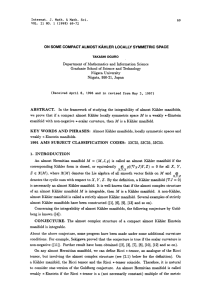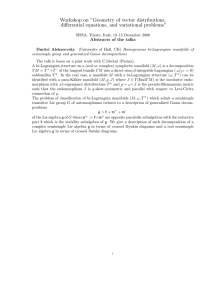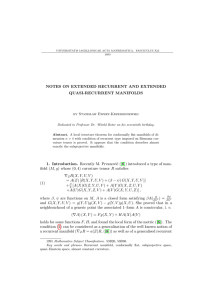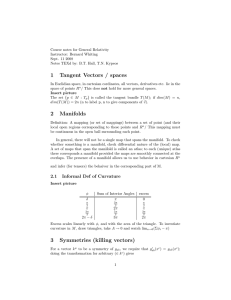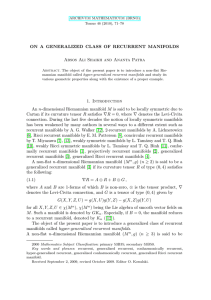Beitr¨ age zur Algebra und Geometrie Contributions to Algebra and Geometry
advertisement
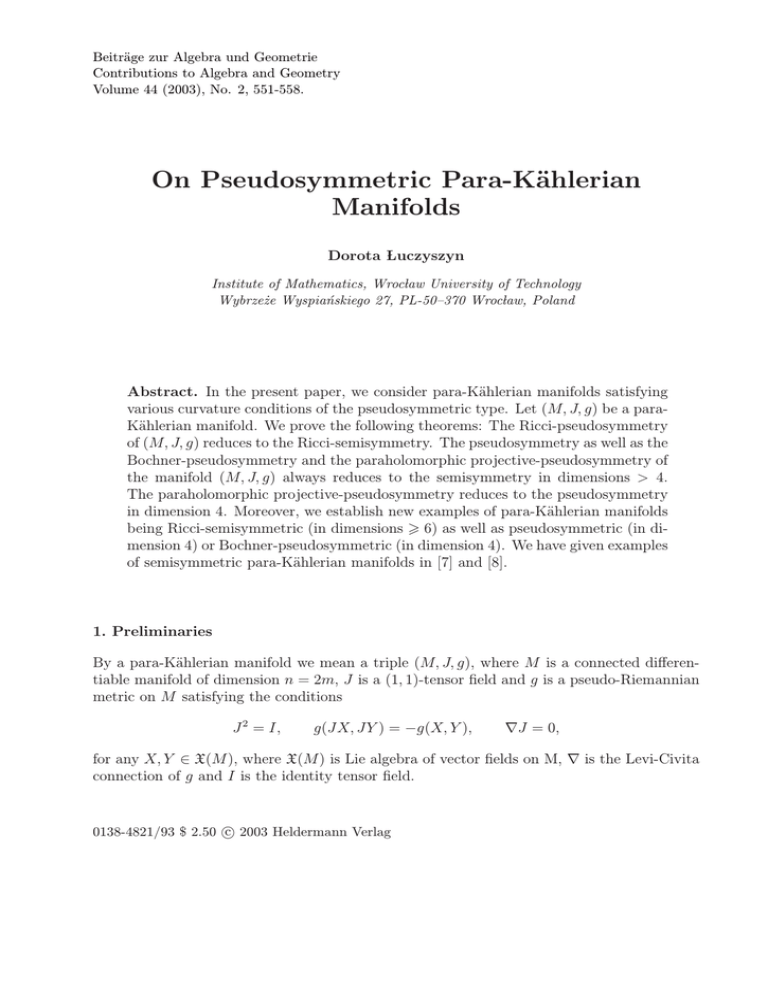
Beiträge zur Algebra und Geometrie
Contributions to Algebra and Geometry
Volume 44 (2003), No. 2, 551-558.
On Pseudosymmetric Para-Kählerian
Manifolds
Dorota Luczyszyn
Institute of Mathematics, Wroclaw University of Technology
Wybrzeże Wyspiańskiego 27, PL-50–370 Wroclaw, Poland
Abstract. In the present paper, we consider para-Kählerian manifolds satisfying
various curvature conditions of the pseudosymmetric type. Let (M, J, g) be a paraKählerian manifold. We prove the following theorems: The Ricci-pseudosymmetry
of (M, J, g) reduces to the Ricci-semisymmetry. The pseudosymmetry as well as the
Bochner-pseudosymmetry and the paraholomorphic projective-pseudosymmetry of
the manifold (M, J, g) always reduces to the semisymmetry in dimensions > 4.
The paraholomorphic projective-pseudosymmetry reduces to the pseudosymmetry
in dimension 4. Moreover, we establish new examples of para-Kählerian manifolds
being Ricci-semisymmetric (in dimensions > 6) as well as pseudosymmetric (in dimension 4) or Bochner-pseudosymmetric (in dimension 4). We have given examples
of semisymmetric para-Kählerian manifolds in [7] and [8].
1. Preliminaries
By a para-Kählerian manifold we mean a triple (M, J, g), where M is a connected differentiable manifold of dimension n = 2m, J is a (1, 1)-tensor field and g is a pseudo-Riemannian
metric on M satisfying the conditions
J 2 = I,
g(JX, JY ) = −g(X, Y ),
∇J = 0,
for any X, Y ∈ X(M ), where X(M ) is Lie algebra of vector fields on M, ∇ is the Levi-Civita
connection of g and I is the identity tensor field.
c 2003 Heldermann Verlag
0138-4821/93 $ 2.50 552
D. Luczyszyn: On Pseudosymmetric Para-Kählerian Manifolds
Let (M, J, g) be a para-Kählerian manifold. By R(X, Y ) we denote its curvature operator, R(X, Y ) = [∇X , ∇Y ] − ∇[X,Y ] . The Riemann-Christoffel curvature tensor R, the Ricci
curvature tensor S and the scalar curvature r are defined by
R(X, Y, Z, W ) = g(R(X, Y )Z, W ),
S(X, Y ) = Tr { Z 7→ R(Z, X)Y },
r = Trg S.
e Y ). For these tensor fields, the
Let Se be the Ricci operator given by S(X, Y ) = g(SX,
following identities are satisfied
R(JX, JY ) = −R(X, Y ), R(JX, Y ) = −R(X, JY ),
S(JX, Y ) = −S(JY, X), S(JX, JY ) = −S(X, Y ),
Tr { Z 7→ R(X, Y )JZ } = −2S(X, JY ),
Tr { Z 7→ R(JZ, X)Y } = S(X, JY ).
(1)
Next, for a symmetric (0, 2)-tensor field A on M and X, Y ∈ X(M ), we define the endomorphism X ∧A Y of X(M ) by
(X ∧A Y )Z = A(Y, Z)X − A(X, Z)Y,
Z ∈ X(M ).
In the case when A = g, we shall write ∧ instead of ∧g . The Bochner curvature tensor B is
defined by [1], [8]
1
e ) + (SX)
e ∧ Y − (JX) ∧ (SJY
e )
(X ∧ (SY
n+4
e
e + 2g(SJX,
e
− (SJX)
∧ (JY ) + 2g(JX, Y )SJ
Y )J)
r
+
(X ∧ Y − (JX) ∧ (JY ) + 2g(JX, Y )J).
(n + 4)(n + 2)
B(X, Y ) = R(X, Y ) −
Recall that the Bochner curvature (0, 4)-tensor, B(X, Y, Z, W ) = g(B(X, Y )Z, W ), has the
same algebraic properties as the usual curvature tensor. Moreover, for this tensor, we have
B(JX, JY ) = −B(X, Y ),
Tr { Z →
7 B(Z, X)Y } = 0, Tr { Z 7→ B(JZ, X)Y } = 0.
(2)
The paraholomorphic projective curvature tensor P of (M, J, g) is defined in the following
manner [9], [10], [7]
P (X, Y ) = R(X, Y ) −
1
e
(X ∧S Y − (JX) ∧S (JY ) + 2g(SJX,
Y )J).
n+2
Notice that this tensor has the following properties
P (X, Y ) = −P (Y, X), Tr { Z 7→ P (Z, X)Y } = 0,
P
1
(nS(X, W ) − rg(X, W )).
i εi P (X, ei , ei , W ) =
n+2
(3)
In the above and in the sequel, (e1 , e2 , . . . , en ) is an orthonormal frame and εi is the indicator
of ei , εi = g(ei , ei ) = ±1.
D. Luczyszyn: On Pseudosymmetric Para-Kählerian Manifolds
553
2. Main result
For a (0, k)-tensor (k > 1) field T on a pseudo-Riemannian manifold (M, g), we define a
(0, k + 2)-tensor field R · T by the condition
k
X
(R · T )(U, V, X1 , . . . , Xk ) = −
T (X1 , . . . , R(U, V )Xs , . . . , Xk ).
(4)
s=1
A pseudo-Riemannian manifold (M, g) is called: semisymmetric if R · R = 0; Ricci-semisymmetric if R · S = 0 (see [2], [6], [11]).
To formulate the notions of various pseudosymmetry type curvature conditions, we define
also a (0, k + 2)-tensor (k > 1) field Q(g, T )
k
X
Q(g, T )(U, V, X1 , . . . , Xk ) = −
T (X1 , . . . , (U ∧ V )Xs , . . . , Xk ).
(5)
s=1
A pseudo-Riemannian manifold (M, g) is said to be Ricci-pseudosymmetric [6] if there exists
a function LS : M → R such that
R · S = LS Q(g, S).
Clearly, every Ricci-semisymmetric manifold is also Ricci-pseudosymmetric. The converse is
not true in general [6]. However, we shall prove that the Ricci-pseudosymmetry reduces to
the Ricci-semisymmetry in the class of para-Kählerian metrics.
Theorem 1. Every Ricci-pseudosymmetric para-Kählerian manifold is Ricci-semisymmetric.
Proof. Assume that a para-Kählerian manifold (M, J, g) satisfies the condition
(R · S)(U, V, X, Y ) = LS Q(g, S)(U, V, X, Y ).
Note that in virtue of (1) and (4), we have
(R · S)(JU, JV, X, Y ) = −(R · S)(U, V, X, Y ).
Thus by (6), we have
LS Q(g, S)(U, V, X, Y ) = −LS Q(g, S)(JU, JV, X, Y ).
Suppose that LS is non-zero at a certain point p ∈ M . Then the above equality gives
Q(g, S)(U, V, X, Y ) = −Q(g, S)(JU, JV, X, Y ),
or in view of (5)
S(U, Y )g(V, X) − S(V, Y )g(U, X) + S(U, X)g(V, Y )
−S(V, X)g(U, Y ) = −S(Y, JU )g(X, JV ) + S(Y, JV )g(X, JU )
−S(X, JU )g(Y, JV ) + S(X, JV )g(Y, JU ).
(6)
554
D. Luczyszyn: On Pseudosymmetric Para-Kählerian Manifolds
This, by contraction with respect to V, X and applying of (1), we find
S(Y, U ) =
r
g(Y, U ),
n
that is, the manifold is Einstein. This gives R · S = 0, which completes the proof.
Now, we give examples of Ricci-semisymmetric para-Kählerian manifolds.
Example 1. Let (xi ) be the Cartesian coordinates in
Riemannian metric g by
x6 + x23
0
0
x5 + x24
1
0
[g(∂i , ∂j )] =
0
1
0
0
0
0
R6 and ∂i = ∂/∂xi . Define a pseudo1
0
0
0
0
0
0
1
0
0
0
0
0
0
0
0
0
1
0
0
0
0
1
0
and a (1, 1)-tensor field J by
J∂1 = −∂1 + (x6 + x23 )∂3 , J∂2 = ∂2 − (x5 + x24 )∂4 ,
J∂3 = ∂3 , J∂4 = −∂4 , J∂5 = −∂5 , J∂6 = ∂6 .
It is a straightforward verification that (J, g) is a para-Kählerian structure on R6 wich is Riccisemisymmetric and non-semisymmetric (e.g., the component (R · R)131212 = −1/2 6= 0). To
get Ricci-semisymmetric non-semisymmetric manifolds in dimensions n = 6 + 2p, p > 1, it
is sufficient to take the product of the para-Kählerian manifold (R6 , J, g) and the standard
para-Kählerian flat space (R2p , J0 , g0 ).
A pseudo-Riemannian manifold (M, g) is said to be pseudosymmetric [6] if there exists a
function LR : M → R such that
R · R = LR Q(g, R).
(7)
Clearly, every semisymmetric manifold is also pseudosymmetric. The converse is not true in
general [6].
Theorem 2. Let (M, J, g) be a pseudosymmetric para-Kählerian manifold.
(a) If dim M = 4, then (M, J, g) is Ricci flat.
(b) If dim M > 4, then (M, J, g) is semisymmetric.
Proof. Assume that the condition (7) is satisfied everywhere on M . Now, in the same way
as in the proof of Theorem 1, we have
LR Q(g, R)(U, V, X, Y, Z, W ) = −LR Q(g, R)(JU, JV, X, Y, Z, W ).
(8)
D. Luczyszyn: On Pseudosymmetric Para-Kählerian Manifolds
555
Suppose that the function LR is non-zero at a point p ∈ M . Therefore, (8) takes the form
Q(g, R)(U, V, X, Y, Z, W ) = −Q(g, R)(JU, JV, X, Y, Z, W ).
Contracting, the last relation with respect to X, V , we obtain
X
X
i Q(g, R)(U, ei , ei , Y, Z, W ) = −
i Q(g, R)(JU, Jei , ei , Y, Z, W )
i
i
which, with the help (5), can be rewritten in the following form
nR(U, Y, Z, W ) − R(U, Y, Z, W ) + R(Y, U, Z, W ) + R(Z, Y, U, W )
+ R(W, Y, Z, U ) + g(U, Z)S(Y, W ) − g(U, W )S(Y, Z) =
+ R(U, Y, Z, W ) − R(Y, U, Z, W ) − R(JU, W, Y, JZ) + R(JU, Z, Y, JW )
+ 2g(Y, JU )S(Z, JW ) − g(Z, JU )S(W, JY ) + g(W, JU )S(Z, JY ).
Hence, using (1) and the first Bianchi identity, we get
(n − 4)R(U, Y, Z, W ) − 2g(Y, JU )S(Z, JW ) + g(Z, JU )S(W, JY )
−g(W, JU )S(Z, JY ) + g(U, Z)S(Y, W ) − g(U, W )S(Y, Z) = 0.
(9)
(a) Let n = 4. Substituting JY instead of Y in (9), contracting the obtained relation with
respect to Y, U and using (1), we find S = 0.
(b) Let n > 4. Contracting (9) with respect to Y, Z, we find
S(U, W ) =
r
g(U, W ).
n
This implies R · S = 0. Using this fact in (9), we obtain R · R = 0.
Examples of semisymmetric para-Kählerian manifolds can be found in [7] and [8]. Below,
we give an example of a 4-dimensional pseudosymmetric para-Kählerian manifold which is
non-semisymmetric.
Example 2. Let U be the open subset of R4 consisting of points at which x1 > 0. Define a
pseudo-Riemannian metric g by
−2x1 0
0
0
0
2x1
0
0
[g(∂i , ∂j )] =
−1
−1
0
0
2x1
−x2 x1
−1
2 −1
0
0 −x2 x1 2x2 x1 − 2x1
and a (1, 1)-tensor field J by
−1
J∂1 = ∂2 , J∂2 = ∂1 , J∂3 = −x2 x−1
1 ∂3 − (2x1 ) ∂4 ,
−1
J∂4 = 2x22 x−1
1 − 2x1 ∂3 + x2 x1 ∂4 .
556
D. Luczyszyn: On Pseudosymmetric Para-Kählerian Manifolds
One verifies that (J, g) is para-Kählerian structure on U . Moreover, it can be checked that
the structure is non-semisymmetric and pseudosymmetric with LR = (2x31 )−1 .
Now, we consider a para-Kählerian manifold, whose Bochner curvature tensor fulfills the
condition
R · B = LB Q(g, B),
where LB is a function on M . Such a manifold will be called Bochner-pseudosymmetric. In
the special case when R · B = 0, the manifold is said to be Bochner-semisymmetric [8].
Theorem 3. Every Bochner-pseudosymmetric para-Kählerian manifold of dimension n > 4
is Bochner-semisymmetric.
Proof. Let (M, J, g) be a para-Kählerian manifold which is Bochner-pseudosymmetric. In
the same manner as in the proof of Theorem 1, we find
LB Q(g, B)(U, V, X, Y, Z, W ) = −LB Q(g, B)(JU, JV, X, Y, Z, W ).
Let LB be non-zero at p ∈ M . Then we have
Q(g, B)(U, V, X, Y, Z, W ) = −Q(g, B)(JU, JV, X, Y, Z, W ),
or in view of (5) with T = B
B(U, Y, Z, W )g(V, X) − B(V, Y, Z, W )g(U, X) + B(X, U, Z, W )g(V, Y )
− B(X, V, Z, W )g(U, Y ) + B(X, Y, U, W )g(V, Z) − B(X, Y, V, W )g(U, Z)
+ B(X, Y, Z, U )g(V, W ) − B(X, Y, Z, V )g(U, W )
= B(JV, Y, Z, W )g(X, JU ) − B(JU, Y, Z, W )g(X, JV )
+ B(X, JV, Z, W )g(Y, JU ) − B(X, JU, Z, W )g(Y, JV ) + B(X, Y, JV, W )g(Z, JU )
− B(X, Y, JU, W )g(Z, JV ) + B(X, Y, Z, JV )g(W, JU ) − B(X, Y, Z, JU )g(W, JV ).
Contracting the last identity with respect to X, V and next using (2) and the first Bianchi
identity for B, we find
(n − 4)B(U, Y, Z, W ) = 0.
This gives immediately B = 0, which completes the proof.
Remark 1. In paper [8], we have shown that for a para-Kählerian manifold, the Bochner
semisymmetry always implies the semisymmetry at points where the Bochner tensor does
not vanish.
The assertion of Theorem 3 does not hold in dimension 4; see the following example.
Example 3. Let h be a function on R such that h 6= 0 and h0 6= 0 at any point. On R4 ,
define a pseudo-Riemannian metric g by
−h0 (x1 )/2
0
0
0
0
h(x1 )
0
0
[g(∂i , ∂j )] =
0
0
0
0
h (x1 )/2
−x2 h (x1 )
0
2 0
0
0
−x2 h (x1 ) −h(x1 ) + 2x2 h (x1 )
D. Luczyszyn: On Pseudosymmetric Para-Kählerian Manifolds
557
and a (1, 1)-tensor field J by
J∂1 = ∂3 ,
J∂2 = 2x2 ∂3 + ∂4 ,
J∂3 = ∂1 ,
J∂4 = ∂2 − 2x2 ∂2 .
Then (J, g) is a para-Kählerian structure which is non-pseudosymmetric and Bochner pseudosymmetric with
h(x1 )h00 (x1 ) − h02 (x1 )
LB =
.
h2 (x1 )h0 (x1 )
A para-Kählerian manifold (M, J, g) will be called paraholomorphic projective-pseudosymmetric if there exists a function LP : M → R such that
R · P = LP Q(g, P ).
Theorem 4. Let (M, J, g) be a paraholomorphic projective-pseudosymmetric para-Kählerian
manifold.
(a) If dim M = 4, then (M, J, g) is Ricci flat and pseudosymmetric.
(b) If dim M > 4, then (M, J, g) is semisymmetric.
Proof. If R · P = 0 at a certain point of M , then R · R = 0 at this point (it was really shown
in the paper [7], Theorem 1, since this is a pointwise property). In the sequel, we assume
that R · P 6= 0 at a point of M . Let G be the contracted tensor P ,
X
G(X, W ) =
i P (X, ei , ei , W ).
i
Thus, by (3), we have
G(X, W ) =
1
(nS(X, W ) − rg(X, W )).
n+2
(10)
Since (M, J, g) is paraholomorphic projective-pseudosymmetric, the following formula is fulfilled
(R · P )(U, V, X, Y, Z, W ) = LP Q(g, P )(U, V, X, Y, Z, W ).
(11)
Contracting (11) with respect to Y, Z and using (4) and (5), we obtain
(R · G)(U, V, X, W ) = LP Q(g, P )(U, V, X, W ).
Hence, using (10) and (4), we get
(R · S)(U, V, X, W ) = LP Q(g, S)(U, V, X, W ).
This by Theorem 1 implies R · S = 0. Note that LP is non-zero at p. Then Q(g, S) = 0 at
this point. Therefore, in virtue of (3) and (11), we find R · R = LP Q(g, R). Thus, (M, J, g)
is pseudosymmetric. To finish the proof it is sufficient to use Theorem 2.
558
D. Luczyszyn: On Pseudosymmetric Para-Kählerian Manifolds
Final remarks. 1. The notion of the para-Kählerian manifold used in the presented paper
is different from that applied in papers [6], [5], where the structure tensor J is an almost
complex structure and the metric g is positive definite.
2. The local components of geometric objects (that is, the Levi-Civita connection, the Riemann, Ricci, Bochner and paraholomorphic projective curvature tensors and the scalar curvature) in our examples were calculated with the help of Mathematica programs.
Acknowledgment. The author wishes to express her gratitudes to Prof. Zbigniew Olszak
for his instant assistance during the preparation of this paper.
References
[1] Bejan, C. L.: The Bochner curvature tensor on a hyperbolic Kähler manifold. In: Colloquia Mathematica Societatis Jànos Bolyai, 56. Differential Geometry, Eger (Hungary)
1989, 93–99.
Zbl
0788.53064
−−−−
−−−−−−−−
[2] Boeckx, E.; Kowalski, O.; Vanhecke, L.: Riemannian manifolds of conullity two. World
Scientific Publishing Co., Singapore 1996.
Zbl
0904.53006
−−−−
−−−−−−−−
[3] Cruceanu, V.; Fortuny, P.; Gadea, P. M.: A survey on paracomplex geometry. Rocky
Mountain J. Math. 26 (1996), 83–115.
Zbl
0856.53049
−−−−
−−−−−−−−
[4] Cruceanu, V.; Gadea, P. M.; Munõz Masqué, J.: Para-Hermitian and para-Kähler manifolds. Quaderni Inst. Mat. Messina 2 (1995), 1–70.
[5] Defever, F.; Deszcz, R.; Verstraelen, L.: On semisymmetric para-Kähler manifolds. Acta
Math. Hungarica 74 (1997), 7–17.
Zbl
0922.53009
−−−−
−−−−−−−−
[6] Deszcz, R.: On pseudosymmetric spaces. Bull. Soc. Math. Belg. Sér. A 44 (1992), 1–34.
[7] Luczyszyn, D.: On para-Kählerian manifolds with recurrent paraholomorphic projective
curvature. Math. Balkanica 14 (2000), 167–176.
[8] Luczyszyn, D.: On Bochner semisymmetric para-Kählerian manifolds. Demonstratio
Math. 4 (2001), 933–942.
Zbl pre01717437
−−−−−−−−−−−−−
[9] Prvanović, M.: Holomorphically projective transformations in a locally product space.
Math. Balkanica N.S. 1 (1971), 195–213.
Zbl
0221.53062
−−−−
−−−−−−−−
[10] Reyes, E.; Montesinos, A.; Gadea, P. M.: Projective torsion and curvature, axiom of
planes and free mobility for almost-product manifolds. Ann. Polon. Math. 48 (1988),
307–330.
Zbl
0678.53029
0678.53030
−−−−
−−−−−−−− and Zbl
−−−−
−−−−−−−−
[11] Szabó, Z. I.: Structure theorems on Riemannian spaces satisfying R(X, Y )R = 0, I, Local
version. J. Diff. Geom. 17 (1982), 531–582;
Zbl
0508.53025
−−−−
−−−−−−−−
II, Global versions. Geom. Dedicata 19 (1985), 65–108.
Zbl
0612.53023
−−−−
−−−−−−−−
Received July 30, 2001



